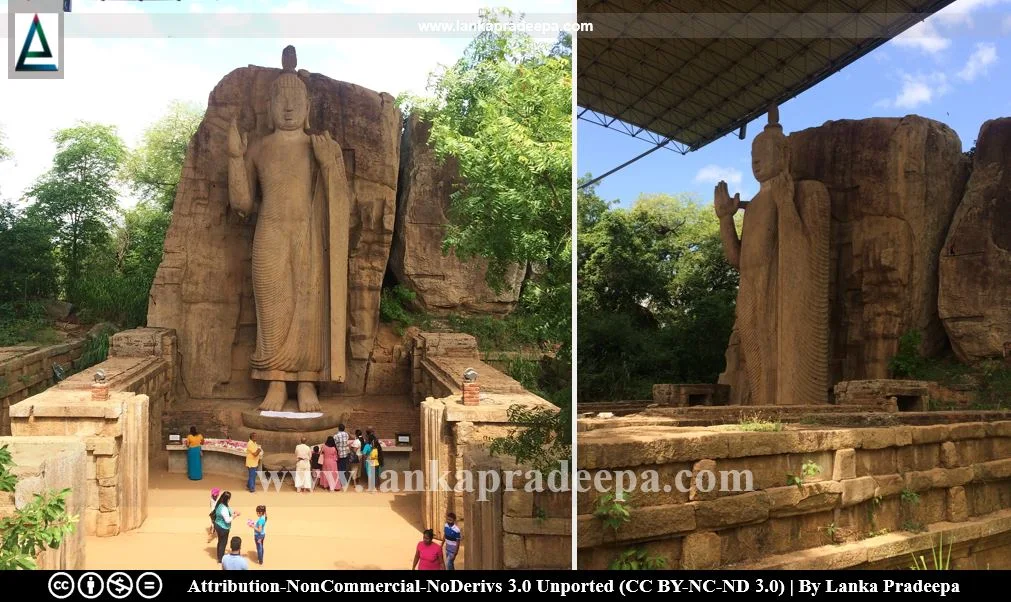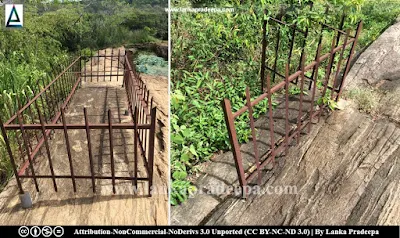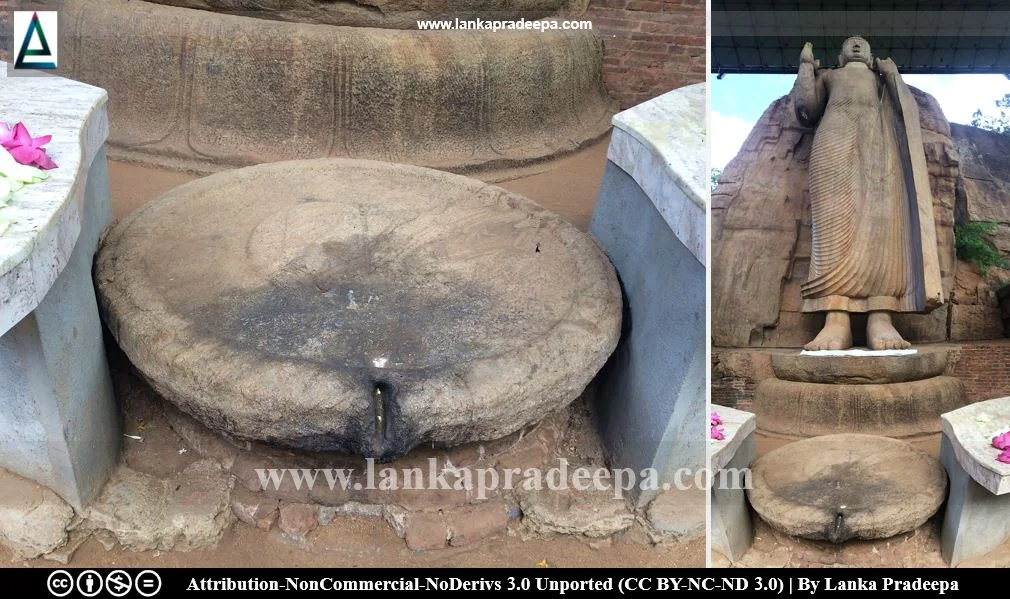
The Avukana Buddha Statue (Sinhala: අවුකන බුද්ධ ප්රථිමාව) is an ancient rock-cut Buddha statue located on the premises of Avukana Raja Maha Viharaya in Anuradhapura District, Sri Lanka.
History
From the inscriptions found on the premises, the history of the Avukana temple can be dated back to the 1st century A.D. (Nicholas, 1963; Paranavitana, 1970).
Period: 1st century A.D. Script: Later Brahmi Language: Old Sinhala
Transcript: Pukana lene Padagama Data jetha tipati dina Pusa mahata vare
Translation: The cave of the members of the Corporation. The alderman, Datta of Padagama, gave the three categories of revenue (to the cave) on the day when Phussa was president.
Citation: Paranavitana, 1970
There is a controversy regarding the time of the Avukana image. Scholars have pointed out that the Buddha statue at Avukana could be the same statue mentioned in the Sri Lankan historical record Culavamsa. According to Culavamsa, an image of Buddha had been constructed during the reign of King Dhatusena (455-473 A.D.) in the name of 'Kalasela Sathu Pathima' (Vanarathana Thera, 1990). The name 'Kalasela' is the Pali (language) equivalent of 'Kalagala' and is also the old name for Avukana occurring in the documents of the Kandy period (Ray, 1959).
However, depending on the characteristic features of the statue other scholars have dated this image to the 8th century A.D. (Deegalle, 1999; Vanarathana Thera, 1990). A donatory inscription found from the site mentions the shrine which encloses the Avukana Buddha statue (Ray, 1959). That inscription has been written in characters of about the 8th-9th centuries A.D. but it does not record anything about the image.

Avukana Rock Inscription
Period: 1st century A.D.
Scripts: Later Brahmi
Language: Old Sinhala
Transcript: Si(ddham) Vayavada Tisaha puti
Bahuravamati Kalubaha Vava Saga dini
Content: Kalabaha Tank of Mata of Bahakava
was given to the Sangha by the son of Tissa
of Vayavada.
Reference: Nicholas, 1950; The information
board at the site by the Director-General of
Archaeology.
Avukana Vihara Slab Inscription
Period: 9-10th century A.D. Script: Medieval Sinhala Language: Medieval Sinhala
Transcript: (1) Det-atgamu da...(2) Urahadabeva vehe(ra) (3) (tabu) pahana yi
Translation: (This is) the stone (slab) placed by Da... of Det-atgama at Urahadabeva Monastery.
Citation: Ranawella, 2005.
The Statue
The statue is 38 feet, 10 inches in height, and has been carved out of living rock (Uduwara, 1990; Vanarathana Thera, 1990). A narrow strip has been left at the back of the image to keep the statue connected with the rock. On the head of the statue is a "Siraspota" symbolizing the radiance of the supreme knowledge of the Buddha and it is said to have been added to the image during the period of British rule in Sri Lanka [(British Ceylon: 1815 - 1948) Fernando, 1990]. The oval-shaped face is adorned with half-closed long eyes and long ears (Lambakarna). The robe closely touches Buddha's full body but leaves the right shoulder bare. The lotus pedestal of Buddha is said to be a later work added to the statue.
The right hand of the image is in the pose of Abhaya Mudra but the raised palm and the straight fingers of the right hand have led some scholars to interpret that pose as Ashir-Mudra (Vanarathana Thera, 1990). The left hand is in the ring-hand attitude and holding the edge of the robe. The image originally was covered with an image house but only the lower walls of that building remain today (Wikramagamage, 2004).
Conservation
From the excavations done near the lotus pedestal of Avukana Buddha in 1952, archaeologists discovered a statue of Indra along with four other images of guardian deities (Deegalle, 1999). They were found deposited in a stone receptacle containing 25 compartments (Wikramagamage, 2004). It is believed that these statues had been deposited here at the time when the lotus pedestal was added to the image (Vanarathana Thera, 1990). Professor Senarath Paranavithana has named these figures Indra, Brahma, Yama, Kuvera, and Varuna (Vanarathana Thera, 1990).
A wooden hood fixed on a railway girder had been added to the image later by Railway employees to protect the statue but it fell into disuse in the twenties (Uduwara, 1990). As it obscured the view of the image and made a threat of collapse, the Archaeological Department carefully removed the wooden hood but again in the middle of requests from Buddhist organizations for the installation of a new cover around the statue (Fernando, 1990; Uduwara, 1990). As a result of these repeated requests, the then Sri Lankan President William Gopallawa laid the foundation stone for building a shelter around the statue on 6 July 1974 and the Department of Archaeology built a vaulted roof with a facade stimulating a later Anuradhapura image house (Uduwara, 1990). In 1978, certain changes were made to the facade (Uduwara, 1990). However, this facade was also removed by the department later.
A Protected Monument
In 1941, the site including the statue was declared a protected area under the Antiquities Ordinance by the Archaeological Department, and conservation work was started at the site in 1948 (Fernando, 1990).



References
1) Deegalle, M., 1999. a Search for Mahāyāna in Sri lanka. Journal of the
International Association of Buddhist Studies, 22(2), pp.343-357.
2) Fernando, W.B.M., 1990. [Wijesekara, N. (Editor in chief)] Section III: History of the Department of Archaeology, Sri Lanka; 1930-1950. Archaeological Department Centenary (1890-1990): Commemorative Series: Vol. I: History of the Department of Archaeology. pp.109-110.
3) Nicholas, C.W., 1950. Some offices and titles in the early Sinhalese kingdom. University of Ceylon Review. pp.116-128.
4) Nicholas, C. W., 1963. Historical topography of ancient and medieval Ceylon. Journal of the Ceylon Branch of the Royal Asiatic
Society, New Series, vol VI, Special Number: Colombo. Royal Asiatic
Society (Ceylon Branch). pp.166-167.
5) Paranavitana, S., 1970. Inscription of Ceylon (Vol. I). Department of Archaeology Ceylon. pp.91-92.
6) Ranawella, S., 2005. Inscription of Ceylon. Volume V, Part
III. Department of Archaeology. ISBN: 955-91-59-57-7. p.153.
7) Ray, H.C. (Editor in chief), 1959. History of Ceylon: Vol. I: Part I. Ceylon University Press. Colombo. p.405.
8) Uduwara, J., 1990. History of the Department of Archaeology, 1970-1990. Archaeological Department Centenary (1890-1990): Commemorative series: Volume I: History of the Department of Archaeology. p.166.
9) Vanarathana Thera, K., 1990. [Wijesekara, N. (Editor in chief)] Section I: 248 BC - 500 A.D. Archaeological Department Centenary (1890-1990): Commemorative Series: Vol. IV: Sculpture. pp.29-30.
10) Wikramagamage, C., 2004. Heritage of Rajarata: Major natural, cultural and historic sites: Colombo. Central Bank of Sri Lanka. pp.31-32.

